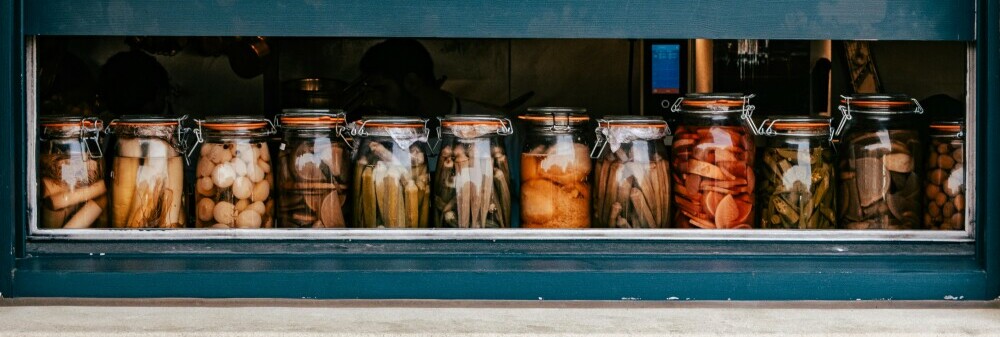This article contains affiliate links. For more information, please read my Affliate Disclosure
In homesteading traditions, food preservation stands as a cornerstone in history, nutrition, and self-sufficiency. Among the various methods of preserving food, canning and fermentation emerge as timeless techniques that not only extend the shelf life of perishables but also enhance flavors and unlock nutritional benefits. Let’s delve into the world of food preservation, exploring its historical significance, the basics of canning, the art of fermentation, and essential tips for beginners.
Historical Significance of Food Preservation in Homesteading
The roots of food preservation run deep, tracing back to ancient civilizations where drying, salting, and fermenting were common practices to store food for leaner times. In the context of homesteading, early settlers relied on these techniques to sustain themselves through harsh winters and remote living conditions. Preserving fruits, vegetables, and meats ensured a stable food supply, fostering self-reliance and resilience in homestead communities.
Canning: Basics and Benefits
What is Canning?
Canning is a method of preserving food in airtight containers, typically glass jars, by heating them to destroy microorganisms that cause spoilage. This process creates a vacuum seal that prevents the entry of new contaminants, extending the shelf life of canned goods.
Benefits of Canning
- Longevity: Canned foods can last for years, maintaining their quality and nutritional value.
- Nutrition: Retains vitamins and minerals, making seasonal produce available year-round.
- Flavor: Preserves the fresh taste of fruits, vegetables, and even meats.
- Self-Sufficiency: Reduces dependence on store-bought goods, promoting sustainability and resourcefulness.
Getting Started with Canning: A Step-by-Step Guide
- Gather Supplies: Mason jars, lids, bands, canning pot, jar lifter, canning funnel, and a reliable recipe. Mason Jars
- Prepare Ingredients: Wash and chop fruits or vegetables, and ensure they are fresh and ripe.
- Sterilize Jars: Boil jars, lids, and bands to sterilize them thoroughly. Canning pots
- Fill Jars: Use a canning funnel to fill jars with prepared ingredients, leaving appropriate headspace.
- Apply Lids: Wipe jar rims, place lids on jars, and tighten bands until just fingertip-tight.
- Process Jars: Submerge jars in boiling water for the recommended time based on the recipe.
- Cool and Store: Remove jars using a jar lifter, let them cool, and check seals before storing in a cool, dark place.
Safety Tips: Follow tested recipes from reputable sources, ensure proper canning techniques to prevent contamination, and inspect jars for signs of spoilage before consumption.
Embracing Fermentation: A Natural Preservation Method
Fermentation is a natural process where microorganisms like bacteria and yeast break down sugars into acids or alcohol, preserving food and enhancing flavors. This age-old technique is celebrated for its health benefits, particularly in promoting gut health through probiotics found in fermented foods.
Health Advantages of Fermented Foods
- Probiotics: Beneficial bacteria in fermented foods support digestion and boost immune function.
- Gut Health: Improves gut flora balance, aiding in nutrient absorption and overall well-being.
Fermentation vs. Canning: Understanding the Differences
While both methods preserve food, they differ in approach and outcomes. Canning relies on heat to kill microorganisms, while fermentation harnesses beneficial microbes to transform food. Fermented foods often have unique flavors and textures compared to canned goods, offering a diverse culinary experience.
Starting Your Fermentation Journey: A Beginner’s Guide
- Choose Your Ingredients: Vegetables, fruits, dairy, or grains can be fermented into various foods like sauerkraut, kimchi, yogurt, or kombucha.
- Prepare Ingredients: Clean and chop ingredients as needed, adding salt, sugar, or starter cultures if required.
- Fermentation Vessel: Use glass jars, crocks, or fermentation kits to ferment foods safely. Fermenting kit
- Fermentation Process: Seal containers and let natural fermentation occur at room temperature, monitoring progress and taste.
- Storage: Transfer fermented foods to the refrigerator or cool storage once they reach the desired flavor and texture.
Common Mistakes to Avoid: Inconsistent temperatures, improper sealing, and contamination can lead to fermentation failures. Use clean equipment and follow recipes closely for successful fermentation.
Resources for Further Learning and Community Connection
Check out resources such as books, online forums, and local homesteading groups to deepen your knowledge and connect with like-minded individuals. Sharing experiences, tips, and recipes within the homesteading community can enrich your food preservation journey.
Food preservation through canning and fermentation embodies the spirit of self-reliance, sustainability, and culinary creativity in homesteading. By mastering these techniques and embracing the wealth of resources available, you can embark on a flavorful and nutritious adventure while preserving the bounty of each season for your homestead table.
Happy Homesteading
Faith xx

